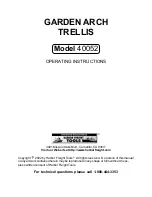
Gilson Company, Inc.
Vibro-Deairator: SGA-5R & SGA-5RT
Page 5
3.3 SG-15 Plastic Pycnometer:
Place the adapter ring of the SGA-7 Adapter Set between
the four rubber bumpers on the agitator base, then posi-
tion the SGA-15 on the ring. The upper adapter of the
SGA-7 is placed with the foam side down on top of the
pycnometer. Slide the top plate over the adjustment rods
and position the adapter between the four adapters (see
Figure 3). Adjust the plastic threaded knobs until there is
a small gap between the plate and the knobs. Drop the
metal speed-knobs onto the rods and tighten so that the
plate is pushed down slightly and contacts the threaded
knobs. Before turning on the Vibro-Deairator, always check
that both sets of knobs are secure.
NOTE:
Pycnometers must be secured but NOT
over-tightened. Over-tightening can damage the
pycnometer or result in loss of action.
4.0 OPERATING INSTRUCTIONS:
NOTE:
If the Vibro-Deairator is started with the
vibration control set to LOW, the vibrator may start
slowly, or not at all. If this occurs, rotate the knob
counter-clockwise to a higher setting, then reduce
the setting once the vibrator is running.
Rotate the vibration control knob on the right counter-
clockwise to its <OFF> position. Push the mode switch
on the left to <Manual Mode> (see Figure 4). Turn the
amplitude knob clockwise to turn on vibration.
NOTE:
When switched to ON, the amplitude control
goes immediately to MAXIMUM. Continue adjusting
clockwise to minimum.
Due to varying pycnometer and sample weights, the
operator must determine the minimum time and vibra-
tion level necessary to dislodge entrapped air without
degrading the sample.
NOTE:
Excessive vibratory action will degrade the
sample particles by abrasion.
Start the test by moving the mode switch to the <TIMED>
position and pressing the <START/STOP> button on the
timer (see below for timer set-up). The unit will run to the
set-time and stop. The timer need not be reset unless a
different run time is required.
This unit is equipped with an easy-to-operate Gilson
interval count-down timer. The timer has a large 0.6in
LED display and will operate in four different modes. It is
powered by line voltage and will work on power supplies
from 100—265 VAC, 50/60Hz, with up to 20 amps Induc-
tive or Resistive current.
NOTE:
Operation of the vibratory motor for the
SGA-5R is limited to 115V/60Hz AC. For 230V/50Hz
operation, the TR-200 Step-Down Transformer or
equivalent must be used.
Current timer mode is indicated by the four red LED’s on
the timer face (see Figure 4).
A = MMSS (99min:59sec x 1 second)
B = HHMM (99hr:59min x 1 minute)
C = SSSS (9999sec x 1 second)
D = MMMM (9999min x 1 minute)
H is for hours, M for minutes, and S for seconds. To ad-
just the timer mode, press and hold both the <UP> and
<DOWN> arrow keys at the same time until the display
shows the mode. Once the mode letters are displayed,
press the <UP> or <DOWN> key to change modes. Press
the <START> key to accept new mode.
To set the run time, press either the <UP> or <DOWN>
arrow key. The first digit on the right hand side will flash in
half-second intervals. Press either arrow key to adjust to
the desired value. To enter the displayed digit and move
to the next, press the <START/STOP> key. Once the last
digit on the left is entered, the timer is ready to start.
Press the <START/STOP> key to initiate the run program.
Once running, pressing the <START/STOP> key again
will pause the timer with the current amount of time re-
maining on screen. When allowed to time-out, the timer
beeps and displays DONE. Press any key to continue.
Setting and Mode values are saved automatically and
restored on power-up.



























